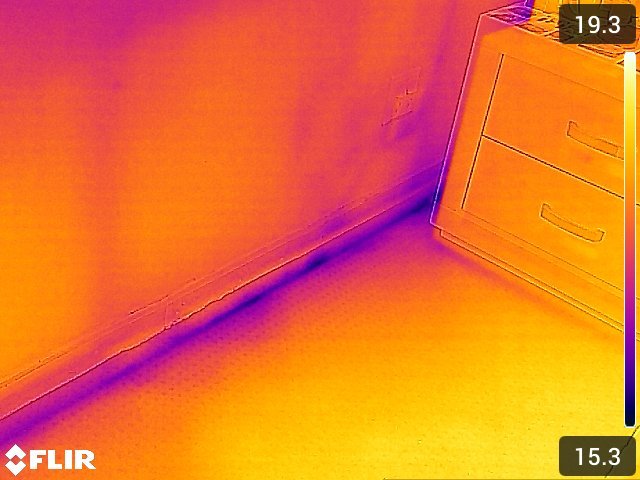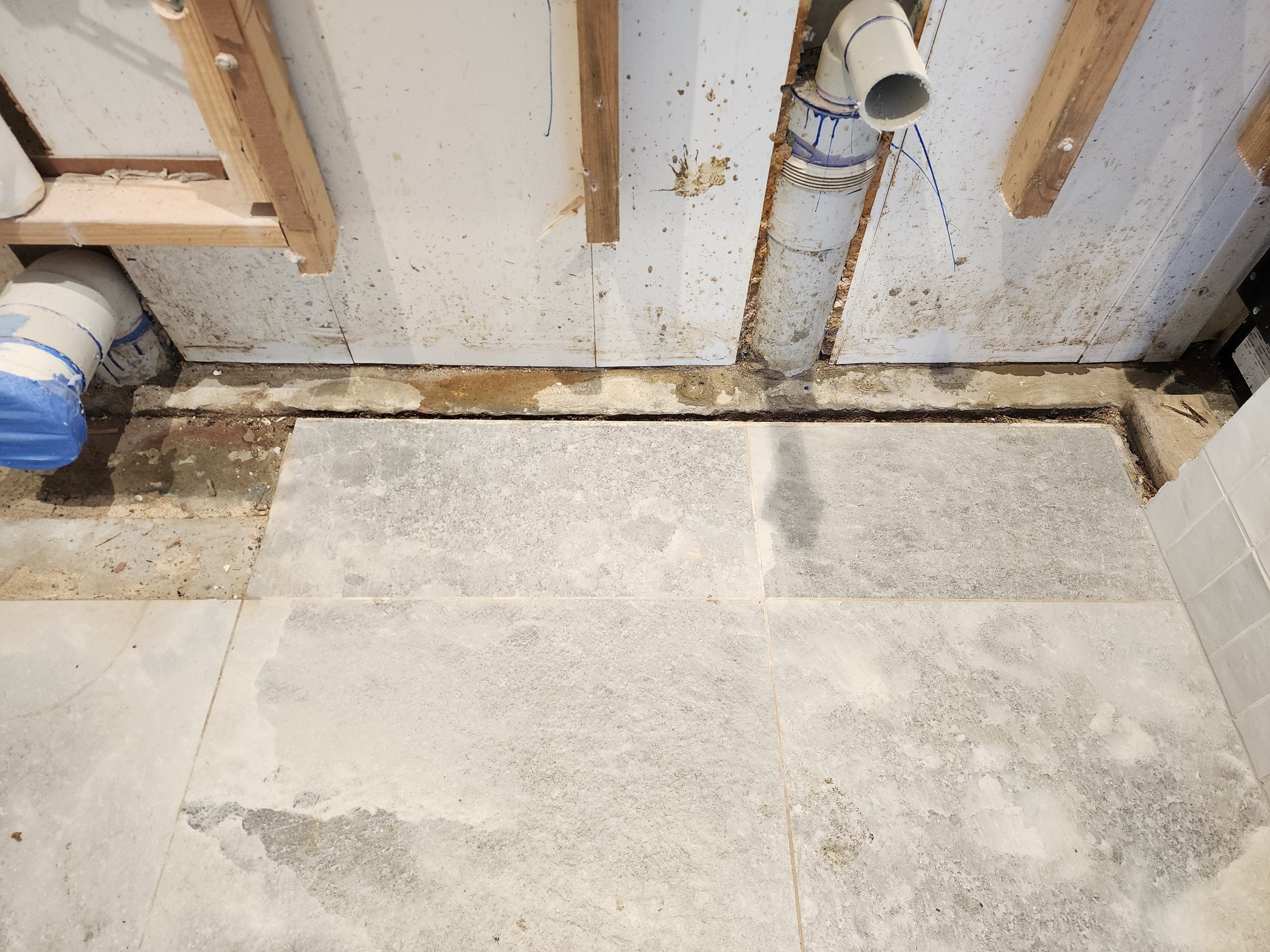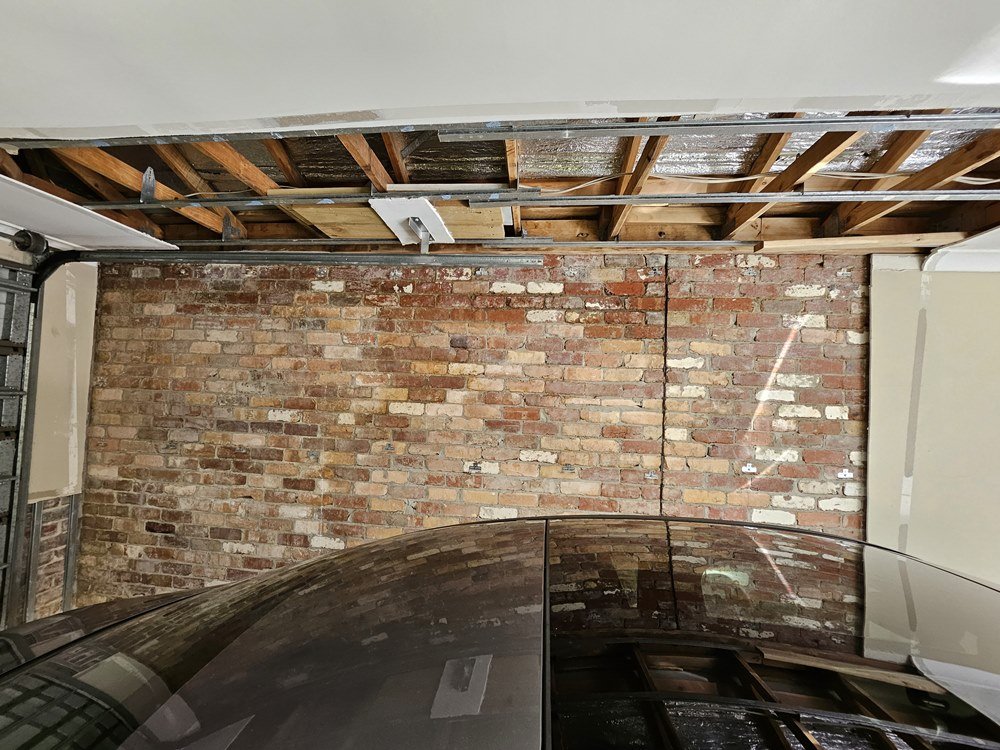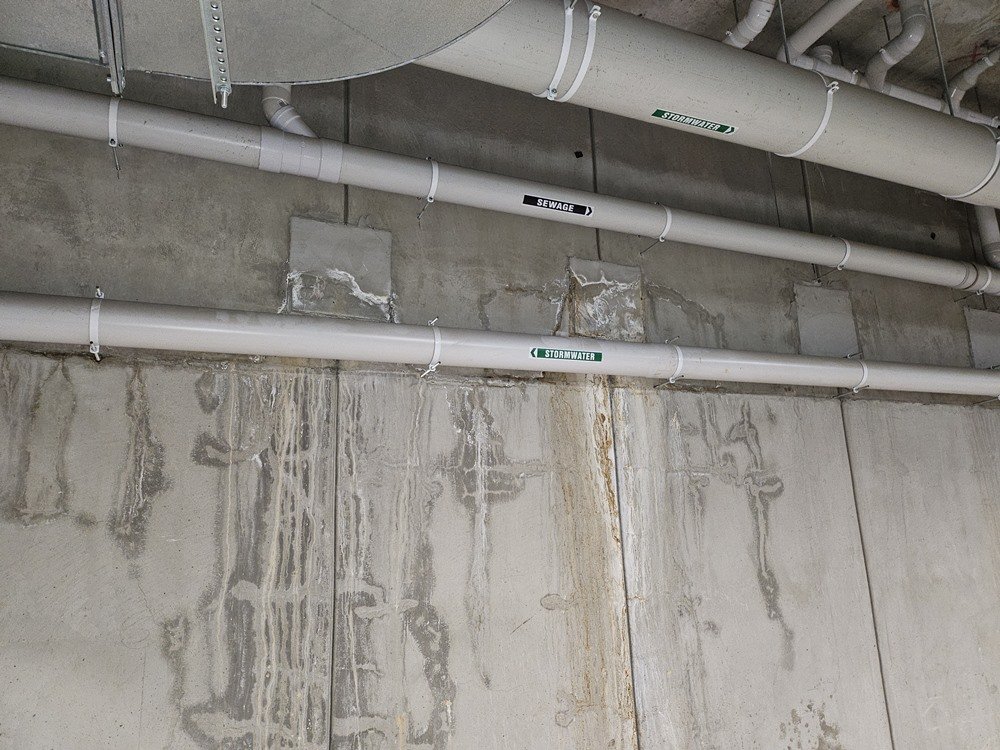BUILDING LEAK DETECTION
and Remedial Services | 1300 FINDLEAK
Commercial & Residential
Building leaks, a wide spread issue in both residential and commercial structures, can cause significant damage if not addressed promptly. These leaks can lead to a range of detrimental effects on structures, such as the weakening of building materials, mold growth, and electrical hazards. Additionally, water ingress can cause aesthetic damage, reduce property value, and increase repair costs. Understanding and mitigating these risks through regular maintenance and timely repairs is crucial for the longevity and safety of buildings.
Comprehensive Building Leak Detection and Repairs
Our expert team identifies and repairs leaks in all building structures, ensuring long-term protection against water damage.
Identifying Water Damage from a Leaking Waste Stack Pipe in High-Rise Apartment
A comprehensive leak detection inspection at a 20-storey apartment building uncovered the source of significant water damage and ingress under the skirting board of a bedroom. The issue was traced to holes in a 150mm waste stack pipe connected to the ensuite toilet and kitchen sink waste pipe. Advanced diagnostic techniques, including thermal imaging, moisture surveys, acoustic listening, tracer gas detection, and water testing, revealed moisture levels exceeding 81%, classifying the area as wet. Plumbing tests in the ensuite passed without issue; however, water testing of the kitchen sink waste pipe showed increased water ingress, confirmed by thermal imaging. The holes in the stack pipe caused water to leak, leading to damage from the internal wall footing to the adjacent skirting board. This case highlights the importance of timely and accurate leak detection to prevent further structural damage in high-rise buildings.
Voted #1 Leak Detection Specialist By Our Partners
Non-Invasive Leak Detection for Accurate Results
Using advanced thermal imaging, moisture detection, and tracer gas, we locate hidden leaks without disrupting your property.
What are common causes of building leaks?
1. Roofing Defects
Roofing defects, including misaligned shingles, broken tiles, and deteriorating seals, are one of the most frequent causes of leaks. A well-maintained roof is critical to preventing water from entering your building through the ceiling and walls.
2. Faulty Plumbing
Leaks from defective or poorly maintained plumbing systems can cause extensive water damage. These can include burst pipes, corroded fixtures, or improperly sealed joints, often resulting in hidden water leaks that may not be immediately visible.
3. Failed Doors and Windows
Doors and windows are common weak points for water ingress. Failed seals, cracks, or improperly installed doors and windows allow rainwater and moisture to penetrate, causing leaks and subsequent damage to interior walls and floors.
4. Inadequate Water Management and Drainage Plans
Poor drainage systems or inadequate water management plans can lead to water pooling near the foundation of the building. Over time, this can seep into walls and floors, leading to moisture buildup and water damage.
5. Slab Heave
Slab heave is caused when reactive clay soils expand under the foundation, resulting in cracks and leaks. This typically occurs in buildings without proper foundation protection, leading to structural shifts that damage plumbing and waterproofing systems.
6. Rising Damp
Rising damp occurs when groundwater moves upward through porous materials such as brick and concrete. This can lead to damp walls, mold growth, and compromised indoor air quality.
7. Efflorescence
Efflorescence refers to the white, powdery deposits of salts left behind when water evaporates from building surfaces. This usually indicates moisture problems that can weaken structural materials and result in leaks.
8. Building Compliance and NCC Breaches
Non-compliance with the National Construction Code (NCC) can result in poor construction practices, which increase the likelihood of building leaks. Breaches in building compliance often include inadequate waterproofing, improper drainage, or incorrect material usage.
9. Waterproofing Failure
Failed waterproofing in areas such as bathrooms, balconies, and basements can allow water to seep into the structure. Over time, this can lead to significant leaks, causing damage to walls, floors, and ceilings.
What is water ingress?
When it comes to buildings, the term water ingress is used to describe the action of water infiltrating a property.
-
Water ingress normally occurs due to some sort of defect in the building such as cracks in the render allowing water to penetrate the property and, unsurprisingly, can lead to a host of damp related problems if left to its own devices such as
Damp plasterwork
Increased heat loss
Damp musty smells
Frost damage to masonry
Wet rot & Dry rot
Unsightly water damage
Given the consequences of repeated water ingress, we recommend that if you identify problematic areas of water ingress in your property, contact our specialist to investigate the source of the water ingress. Prevent moisture ingress and penetrating damp causing any further damage to your home or business.
-
There is a myriad of causes of water ingress. Listed below are four of the most common reasons:
Damaged Walls - Deterioration over time can result in brickwork, rendering, and mortar becoming porous and allowing water to ingress through the wall.
Leaking or defective drainage or plumbing - Defective, blocked, or cracked guttering and downpipes along with faulty internal plumbing.
Roof damage - Broken slates or tiles, flashing around the chimney, A/C, and drain vents may be faulty.
Ingress into the basement - If you have a basement, or if the external ground level has been raised and you have inadequate waterproofing, then you may find water ingressing into the building.
-
The first step in dealing with water ingress is to locate and identify the source of the water ingress. It is essential that you address and fix the source before any consideration can take place to restore your property.
Often the cause of water ingress has DIY remedial options, or you can use the help of a tradesman. To help guide you a little better, we have outlined a list of steps you can take to help protect your property. DIY tips. Alternatively, you can always use our professional damp specialist for recommendations.
As one of the industry leaders, 1-300-FINDLEAK have unmatched experience and knowledge when it comes to identifying water ingress, diagnosing related damp problems to comprehensively solve your water ingress problems and related damp hazards.
Experienced Technicians Specializing in Building Leak Detection
Our skilled team uses the latest tools and techniques, ensuring accurate detection and quality repairs for all types of buildings.
Understanding Slab Heave: Causes, Signs, and Remediation
-
Slab heave refers to the uneven movement of a house's footing and slab, a phenomenon that occurs when the underlying soil expands unevenly due to moisture absorption. This expansion can lift or lower different sections of a building's foundation, leading to structural instability.
-
The primary cause of slab heave is the presence of reactive clay soils beneath the concrete slabs, which swell upon absorbing moisture. Key contributors to soil saturation include:
Excessive rainwater
Broken sewer or stormwater pipes
Inadequate water management practices
Undetected burst pipes
-
The expansion of clay soils can exert significant upward pressure on the underside of a concrete slab, manifesting in various distressing signs within the building, such as:
Severe cracking in drywalls, trims, rendered surfaces, and tiles
Difficulty in opening or closing windows and doors
Stair-step cracks in brickwork
-
Addressing slab heave can be challenging and often requires a combination of advanced techniques, including:
Underpinning: This method strengthens and stabilizes the existing foundation.
Chemical Injections: These help to stabilize the soil by altering its properties to reduce swelling.
Resistance Piers: These are driven deep into the ground to transfer the structural load to stable soil layers.
Implementing a robust water management plan is crucial to prevent future occurrences of slab heave.
Case Studies:
Several successful remediations have highlighted the effectiveness of these techniques. For instance, a residential building experiencing severe slab heave underwent underpinning and soil stabilization, significantly reducing further damage and restoring structural integrity.
By understanding the causes and signs of slab heave and employing effective remediation strategies, homeowners and builders can better manage and mitigate the risks associated with this complex geological phenomenon.
Advanced Thermal Imaging for Hidden Building Leaks
Our high-resolution thermal imaging equipment detects leaks within walls, floors, and ceilings, pinpointing sources of water ingress.
Rising Damp: Understanding, Diagnosis, and Management
-
Rising damp is a form of moisture ingress where water from the ground ascends through the porous materials of a building's structure by capillary action. It typically affects the lower sections of walls and can lead to structural and aesthetic damage.
-
The primary cause of rising damp is the failure of damp-proof courses (DPC) or their absence, particularly in older buildings. Factors contributing to rising damp include:
Deterioration or bridging of the DPC due to construction faults or alterations, such as increased external ground levels or internal renovations that bypass the DPC layer.
-
Rising damp is indicated by tide marks caused by evaporating water on walls, peeling paint, wallpaper detachment, and salt efflorescence causing plaster to crumble. Diagnosis often involves moisture measurements and may require a detailed survey to differentiate from other types of dampness, such as condensation.
-
Effective treatment can include the installation of a new damp-proof course through methods like chemical DPC injections, which introduce a water-repellent substance into the walls. Modern technology plays a critical role in these treatments, ensuring precise application and lasting results.
-
Preventive measures include maintaining an effective DPC and avoiding structural changes that compromise its integrity. Regular inspections and timely repairs of external ground and plumbing fixtures are crucial to prevent water ingress.
-
Unchecked rising damp can severely damage building materials and finishes, leading to costly repairs. Health-wise, it can aggravate respiratory problems and contribute to unhealthy living conditions due to increased moisture and mold growth.
Understanding and addressing rising damp with appropriate measures can protect both the structural integrity of buildings and the health of their inhabitants. Regular maintenance and professional assessments are recommended to manage and mitigate its effects effectively.
Effective Remedial Solutions for Long-Term Leak Prevention
We offer targeted repairs, waterproofing, and structural reinforcements to prevent future leaks and protect your property.
Understanding Efflorescence: Causes, Prevention, and Treatment
-
Efflorescence is a common issue in the construction industry, manifesting as a white, powdery deposit on surfaces like concrete, bricks, and natural stone. This occurs when water-soluble salts and minerals are brought to the surface by moisture, which evaporates and leaves behind crystalline deposits.
-
Capillarity plays a crucial role in efflorescence. It describes the movement of moisture through porous building materials, driven by the interaction between the liquid and solid surfaces. This process can cause moisture to rise or descend within materials, spreading salts and minerals across various parts of a structure.
-
Efflorescence can be minimized or prevented with several strategies:
Waterproof Membranes: Installing waterproof layers under surfaces can block moisture from reaching building materials, especially in moisture-prone areas.
Sealants: Applying water-repellent sealants can help protect exposed surfaces by reducing water penetration.
Proper Ventilation: Ensuring adequate airflow can help keep surfaces dry and reduce the likelihood of efflorescence.
-
Removing efflorescence involves challenges, especially when it forms beneath surface coatings or on porous materials. Acidic cleaners can dissolve these salts, but care must be taken as these can also damage the materials. It’s crucial to use appropriate cleaning agents and follow up with protective sealants to prevent recurrence.
-
Different materials require specific approaches:
Concrete and Masonry: These may be treated with acidic or neutral cleaners followed by thorough rinsing and drying.
Natural Stone: Care must be taken to avoid damaging sensitive stones like limestone or marble. Mechanical cleaning or mild, stone-safe acids may be used.
By understanding efflorescence and employing proper prevention and maintenance techniques, building owners can preserve the aesthetic and structural integrity of their properties.
Mould-Related Dementia: Sydney Woman Forgets Name Due to Hidden Infestation
An Aussie woman has revealed how a secret mould infestation in her Sydney home led her to being diagnosed with dementia and even forgetting her own name.
The constant wet weather that has plagued Australia east coast in resent times means many residents are now acutely aware of just how quickly mould can take hold in the home – and how difficult it can be to get rid of.
While most people understand that mould is detrimental to our health, it is hard to know just how much of an impact it can have until you experience it first hand.
Why Choose 1300 FINDLEAK for Building Leak and Remedial Services?
At 1300 FINDLEAK, our commitment to building enduring relationships with our valued customers is at the core of our philosophy. With a decade of extensive experience in gas and water leak detection across both residential and commercial environments, our expertise stands unrivaled in the field. Our reputation is further solidified by being trusted by over 200 industry-leading plumbing companies, builders, real estate agents, councils, water suppliers, and property maintenance firms. Our proficiency extends to locating a diverse range of building leaks, whether they are internal or external, encompassing roof leaks, balcony leaks, shower leaks, underground leaks, mysterious or intermittent leaks, and burst pipes for gas and water.
Our team of certified technicians at 1300 FINDLEAK boasts full licensing and insurance, ensuring the delivery of premium service. Armed with cutting-edge equipment including advanced thermal cameras, acoustic leak detection devices, tracer gas detection tools, CCTV camera inspections, moisture mapping technology, fluoro dye testing, roof assessment techniques, and precise Utility Line Locating methods, we steadfastly uphold our position at the forefront of technological advancements. Our unwavering commitment to innovation involves a continuous investment in the latest European tools, thereby allowing us to provide holistic water leak detection solutions across Melbourne. The hallmark of our service lies in its accuracy, efficiency, and the unwavering commitment to customer satisfaction.
Our pricing structure is fixed and determined based on the service required and the specific location, ensuring transparency and affordability. Embrace our services for a dependable and professional approach to identifying and resolving leaks.
Contact 1300 FINDLEAK for Building Leak Detection and Remedial Services
Get in touch today for fast, reliable leak detection and long-lasting remedial solutions for your building.
We're family-owned and run providing you with personalised service where the customer always comes first and is always right. When it comes to leak detection services, Australia can rely on us to care about your home and treat it like it is our own.
No more scary bills! We offer transparent and fixed prices for each job so you can rest easy knowing exactly how much you'll be paying. You can even book online or call us directly for a hassle-free experience.
At 1300 FINDLEAK, we are committed to providing our clients with reliable, professional, and affordable leak detection services in Australia.
Proudly Serving Australia:
Seeking leak detection services in Australia? We service a vast area including Melbourne and Regional Victoria. We also cover areas outside Victoria including Sydney, Wollongong, in Brisbane and the Gold Coast.
Ready for Hassle-Free Leak Detection?
Head to the "Book Online" tab or free call 1300 346 353 for more information. Schedule at your convenience, and let our experts handle the rest.
1300 FINDLEAK – Your Ultimate Shield Against Leaks in Australia!
1300 FINDLEAK is a national leak detection and repair service. We cater to a wide range of clients, including plumbing companies, property maintenance companies, real estate agents, councils, and water suppliers. We have experts who can fix any gas or water leak damage using their skills and knowledge. No job is too big or small, so call the leaders in gas, water and pool leak detection, residential or commercial today!











































